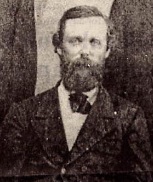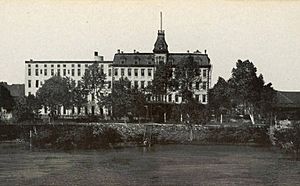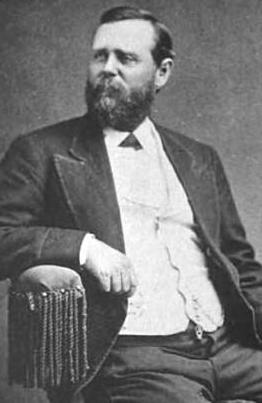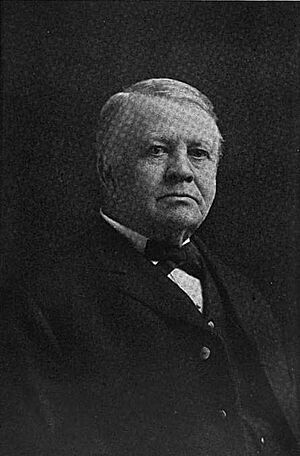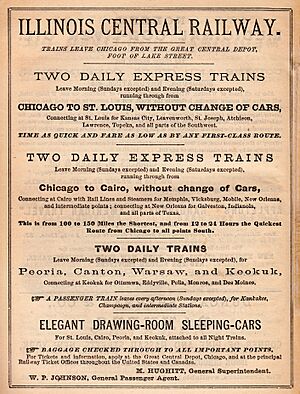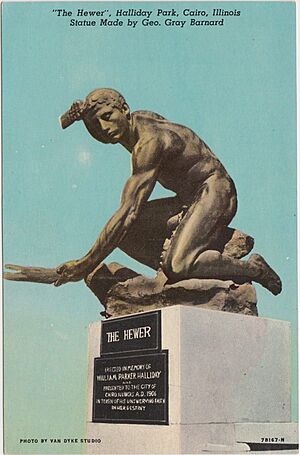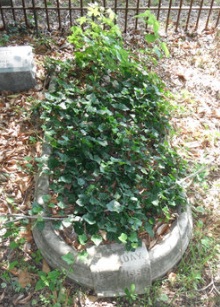William P. Halliday facts for kids
Quick facts for kids
William Parker Halliday
|
|
|---|---|
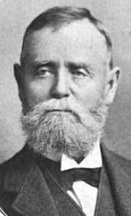 |
|
| Born | July 21, 1827 Rutland, Ohio, US
|
| Died | September 22, 1899 (aged 72) |
| Resting place | Beech Grove Cemetery, Mounds, Illinois |
| Occupation | Steamboat Captain Banker Printer Hotel owner Railroad executive Businessman |
| Known for | River transportation business |
| Board member of | Halliday Brothers Co. City National Bank of Cairo Cairo City Coal Company Cairo Street Railway Company Cairo Telephone Company Cairo Gas Company Halliday Wharf Boat Company Cairo and St. Louis Railroad Cairo and Vincennes Railroad First Bank and Trust Company Halliday Hotel Muddy Valley Mining and Manufacturing Company |
| Spouse(s) | Eliza Craig Wright |
| Children | 6 |
| Relatives | Charles T. Hinde (brother-in law) |
| Signature | |
William Parker Halliday (born July 21, 1827 – died September 22, 1899) was an American steamboat captain, banker, and businessman. He was a pioneer in river and railroad transportation. Halliday played a big part in helping Cairo, Illinois, grow after the American Civil War.
Halliday started his career working on steamboats. He worked on the Mississippi River and Ohio River. Eventually, he became a captain of a steamboat based in Louisville, Kentucky.
Before the Civil War, Halliday thought the war would greatly affect transportation. He moved to Cairo, Illinois, which was a very important location. Cairo is where the Ohio and Mississippi rivers meet. Soon after moving, Halliday started many businesses. These businesses focused on river transportation and general goods. During the war, Halliday became good friends with General Ulysses S. Grant. This friendship helped him become very wealthy.
After the Civil War, Halliday and his four brothers expanded their businesses. They bought land, hotels, mines, and railroads. They also invested in lumber yards, steamboats, and furniture companies. His success helped the entire region grow. He especially helped develop Cairo, Illinois, and Hallidayboro, Illinois.
Contents
Early Life and Career
Halliday was born in Ohio in 1827. He was the oldest of seven children. His father, Samuel Halliday, came from Scotland. Samuel had planned to be a professor at the Ohio University. However, he ended up opening a school in Rutland, Ohio.
William Halliday received a general education in Ohio. His first job was as a printer. He owned a newspaper called the Meigs County Gazette. Later, he worked at the Cincinnati Gazette.
After printing, Halliday became a surveyor. He worked for the United States Department of the Interior. His job was to map parts of the United States.
He then changed careers again. He became a clerk on a steamboat. He worked with Charles T. Hinde, who later married his sister. Halliday slowly moved up in the steamboat business. He eventually became a captain.
In 1860, he moved his family to Cairo, Illinois. He started as a merchant. Over time, he became a very successful businessman. He owned steamboats, hotels, and shipping companies. By the end of his life, he was a multimillionaire.
Halliday and the Civil War
Before the Civil War, Halliday lived in Louisville, Kentucky. He owned a grain business there. In 1860, he moved to Cairo, Illinois. He believed Cairo's location would be important during the war. He set up businesses to help with the conflict.
By February 1861, Halliday had started Halliday, Graham, & Co. He moved his large "wharf boat" to Cairo. A wharf boat is like a floating dock. It helps load and unload goods from ships. People thought his company would be very important for shipping in the Mississippi Valley.
Halliday and his partner, N. W. Graham, made a deal with Ulysses S. Grant. The Union Army used their wharf boat during the war. The contract paid them $1,000 each month. Some people thought this deal was because of Halliday's friendship with General Grant. For a short time, General Grant even had his military headquarters in the Halliday hotel in Cairo.
During the war, Halliday and Grant became close friends. Grant used one of Halliday's wharf boats for the army's food supply. Halliday then worked as a supply agent for the army. He gained Grant's trust. Even though he never joined the army, Halliday went with General Grant to many battles. Halliday's wharf boats also helped connect different railroads in Cairo.
After the Civil War: Business Growth
After the Civil War ended in 1865, Halliday started several railroads. On February 15, 1865, he and others received permission to start the Cairo and Mound City Railroad. The next day, they got approval for the Cairo and St. Louis Railroad.
Also in 1865, Halliday and his brothers started the First Bank and Trust Company. They also bought the largest hotel in Cairo. They renamed it the Halliday Hotel.
Riverlore Mansion: A Steamboat Home
Halliday built the Riverlore Mansion in 1865 in Cairo, Illinois. It was a large brick house with 11 rooms and three floors. It even had a basement. When it was finished, it took up an entire city block.
The mansion had a unique design. It looked like a steamboat. It had a glassed-in pilothouse on the roof. This was like the control room of a boat. The roof was flat, like a steamboat deck. Halliday could stand on his roof and remember his days as a steamboat captain. Captain Halliday lived in the Riverlore for 34 years.
Halliday Brothers' Business Empire
After the Civil War, Halliday and his brothers became very successful. They owned many businesses. People said the Halliday family was one of the most powerful in the region by the 1880s. William Halliday was the most important figure in the family.
The Halliday family owned businesses in Cairo. They had cotton farms in Arkansas. They owned a hotel in Memphis, Tennessee. They also had furniture companies in Memphis and New Orleans. They owned coal mines and salt mines in Illinois and Indiana. They also had many large farms.
To stay connected, Halliday and his brothers put in private telegraph lines. These lines connected their homes to their business offices. In the early 1870s, Halliday also served as a city councilman for Cairo.
Halliday also invested in the Mobile and Ohio Railroad. He became a major investor after the war. His investments helped the railroad expand to Cairo in the late 1870s. In 1874, Halliday was elected to the railroad's board of directors.
As his businesses grew, Halliday invested in related industries. He bought coal mines to supply his steamboats. He also bought land to search for oil. He didn't find oil, but he found a very productive salt mine. His brother-in-law, Marion Wright, managed these mines.
Halliday also helped complete the Cairo and Vincennes Railway. He brought in important investors like banking tycoon J. P. Morgan. Morgan served as president and director of the railroad with Halliday.
Hallidayboro: A Model Town
The town of Muddy Valley, Illinois, was renamed Hallidayboro in 1894. This was done to honor William Halliday. Halliday was a major investor in the Muddy Valley Mining and Manufacturing Company there.
Halliday planned the town based on ideas from his friend George Pullman. Pullman had created a similar industrial town. Halliday wanted to create a good place for his mine workers and their families to live. He wanted to avoid problems between workers and owners.
At its busiest, Halliday's mine employed over 500 men. Both white and black families lived and worked together in Hallidayboro. It was one of the first towns in southern Illinois to have electricity.
Hallidayboro was very different from other "mining camps." It had nice houses with trees and gardens. Journalists called it a "Storybook Village." Workers in Hallidayboro usually worked ten-hour days. But by 1898, Halliday's mines switched to an eight-hour workday. They also agreed to pay union wages.
Halliday also had a strong interest in farming. He owned a cotton plantation in Arkansas. He also had thousands of acres of farmland near Hallidayboro. These farms provided food for the mining families and feed for the mine mules. The company even had its own slaughterhouse. This helped them sell fresh meat at good prices.
William Halliday believed that good living conditions helped workers. He thought that a beautiful town would encourage good character. He hoped that comfortable homes would lead to cleanliness, hard work, and good habits.
Hallidayboro's housing was better than in many other company towns. Electricity was rare in southern Illinois until 1920, but Hallidayboro had it.
Halliday also believed in education. The schoolhouse in Hallidayboro was one of the first buildings. It could hold forty students. Halliday also supported the Cairo Library. He gave $5,000 to the library in his will. This helped expand its collection of books.
Later Life and Legacy
Towards the end of his life, Halliday was the president of the Illinois Bankers Association. In 1885, he was president of the City National Bank of Cairo. The bank had a lot of money available, showing his success.
Since moving to Cairo in 1860, Halliday greatly helped the city grow. People said he was one of the city's strongest supporters. He worked hard and spent money to help Cairo. Many things he built still exist today.
Halliday even named one of his steamboats the William P. Halliday. This boat was mentioned in Mark Twain's writings. Sadly, the boat was destroyed by fire in 1884.
In 1895, Halliday helped start the Ohio Valley Improvement Association. This group worked to collect information about trade and shipping on the Ohio River. They presented this information to the United States Congress. Halliday served as one of the vice presidents.
In 1898, about a year before he died, Halliday sponsored a boat race. It went from Mound City, Illinois to Cairo. He stood by the Halliday House and fired a gun to announce the winning boat.
Halliday spent his last six months in Chicago, Illinois. He died there in 1899 after battling an illness. He was very wealthy when he died.
After Halliday's death, his daughter Mary gave the city of Cairo a statue called The Hewer. This bronze statue was given in honor of her father in 1906. It was a famous work of art by George Grey Barnard.
Images for kids


